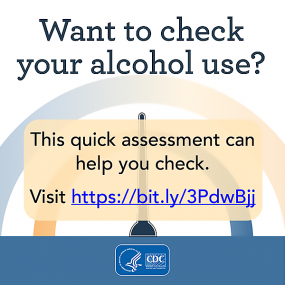Preventing Excessive Alcohol Use

Excessive alcohol use is responsible for about 178,000 deaths in the United States each year1 and $249 billion in economic costs in 2010.2 Excessive alcohol use includes
- Binge drinking (defined as consuming 4 or more alcoholic beverages per occasion for women or 5 or more drinks per occasion for men).
- Heavy drinking (defined as consuming 8 or more alcoholic beverages per week for women or 15 or more alcoholic beverages per week for men).
- Any drinking by pregnant women or those younger than age 21.
The strategies listed below can help communities create social and physical environments that discourage excessive alcohol consumption thereby, reducing alcohol-related fatalities, costs, and other harms.
The Community Preventive Services Task Force Recommendations
The Community Preventive Services Task Force, an independent, nonfederal, volunteer body of public health and prevention experts, recommends several evidence-based community strategies to reduce harmful alcohol use. Learn more about the Community Guide’s findings.
Recommendations
- Regulation of Alcohol Outlet DensityExternal
Alcohol outlet density refers to the number and concentration of alcohol retailers (such as bars, restaurants, liquor stores) in an area.3
- Increasing Alcohol TaxesExternal
Alcohol taxes may include excise, ad valorem, or sales taxes, all of which affect the price of alcohol. Taxes can be levied at the federal, state, or local level on beer, wine or distilled spirits.4
- Dram Shop LiabilityExternal
Dram shop liability, also known as commercial host liability, refers to laws that hold alcohol retail establishments liable for injuries or harms caused by illegal service to intoxicated or underage customers.5
- Maintaining Limits on Days of SaleExternal
States or communities may limit the days that alcohol can legally be sold or served.6
- Maintaining Limits on Hours of SaleExternal
States or communities may limit the hours that alcohol can legally be sold or served.7
- Electronic Screening and Brief Intervention (e-SBI)External
e-SBI uses electronic devices (e.g., computers, telephones, or mobile devices) to facilitate delivery of key elements of traditional screening and brief interventions. At a minimum, e-SBI involves screening individuals for excessive drinking, and delivering a brief intervention, which provides personalized feedback about the risks and consequences of excessive drinking.8
- Enhanced Enforcement of Laws Prohibiting Sales To MinorsExternal
An enhanced enforcement program initiates or increases compliance checks at alcohol retailers (such as bars, restaurants, and liquor stores).9
Recommended against
- Privatization of Retail Alcohol SalesExternal
The privatization of retail alcohol sales refers to the repeal of government (such as state, county, or city) control over the retail sales of one or more types of alcoholic beverages. 10
US Preventive Services Task Force Recommendation
The U.S. Preventive Services Task Force (USPSTF) is an independent panel of non-Federal experts in prevention and evidence-based medicine and comprises primary care providers. The USPSTF conducts scientific evidence reviews of a broad range of clinical preventive health care services and develops recommendations for primary care clinicians and health systems.
- Screening and Brief Intervention for Excessive Drinking in Clinical SettingsExternal
Screening and behavioral counseling interventions to reduce alcohol misuse by adults, including pregnant women, in primary care settings can identify people whose levels or patterns of alcohol consumption do not meet the criteria for alcohol dependence, but place them at increased risk of alcohol-related harms.11
How Can I Contribute to the Prevention of Excessive Alcohol Use?
Everyone can contribute to the prevention of excessive alcohol use.
You can
- Choose not to drink too much yourself and help others not do it.
- Check your drinking, and learn more about the benefits of drinking less alcohol.
- If you choose to drink alcohol, the Dietary Guidelines for Americans recommends that adults of legal drinking age can choose not to drink, or to drink in moderation by limiting intake to 2 drinks or less in a day for men or 1 drink or less in a day for women, on days when alcohol is consumed.12
- Support effective community strategies to prevent excessive alcohol use, such as those recommended by the Community Preventive Services Task ForceExternal.
- Not serve or provide alcohol to those who should not be drinking, including people under the age of 21 or those who have already drank too much.
- Talk with your healthcare provider about your drinking behavior and request counseling if you drink too much.
States and communities can:
- Implement effective prevention strategies for excessive alcohol use, such as those recommended by the Community Preventive Services Task ForceExternal.
- Enforce existing laws and regulations about alcohol sales and service.
- Develop community coalitions that build partnerships between schools, faith-based organizations, law enforcement, health care, and public health agencies to reduce excessive alcohol use.
- Routinely monitor and report the prevalence, frequency, and intensity of binge drinking (whether or not adults binge drink, how often they do so, and how many drinks they have if they do).
- Centers for Disease Control and Prevention. Alcohol-Related Disease Impact (ARDI) website. Accessed February 29, 2024.
- Sacks JJ, Gonzales KR, Bouchery EE, Tomedi LE, Brewer RD. 2010 national and state costs of excessive alcohol consumption. Am J Prev Med 2015; 49(5):e73–e79.
- Campbell CA, Hahn RA, Elder R, Brewer R, Chattopadhyay S, Fielding J, et al. The effectiveness of limiting alcohol outlet density as a means of reducing excessive alcohol consumption and alcohol-related harms [PDF-445KB]. Am J Prev Med. 2009;37(6):556–69.
- Elder RW, Lawrence B, Ferguson A, Naimi TS, Brewer RD, Chattopadhyay SK, et al. The effectiveness of tax policy interventions for reducing excessive alcohol consumption and related harms [PDF-665KB]. Am J Prev Med 2010;38(2):217–29.
- Rammohan V, Hahn RA, Elder R, Brewer R, Fielding J, Naimi TS, et al. Effects of dram shop liability and enhanced overservice law enforcement initiatives on excessive alcohol consumption and related harms: two Community Guide systematic reviews [PDF-569KB]. Am J Prev Med 2011;41(3):334-43.
- Middleton JC, Hahn RA, Kuzara JL, Elder R, Brewer R, Chattopadhyay S, et al. Effectiveness of policies maintaining or restricting days of alcohol sales on excessive alcohol consumption and related harms [PDF-674KB]. Am J Prev Med 2010;39(6):575–89.
- Hahn RA, Kuzara JL, Elder R, Brewer R, Chattopadhyay S, Fielding J, et al. Effectiveness of policies restricting hours of alcohol sales in preventing excessive alcohol consumption and related harms [PDF-735KB]. Am J Prev Med 2010;39(6):590–604.
- Tansil KA, Esser MB, Sandhu P, Reynolds JA, Elder RW, Williamson RS, et al. Alcohol electronic screening and brief intervention: a Community Guide systematic review [PDF-605KB]. Am J Prev Med 2016;51(5):801–11.
- Elder RW, Lawrence B, Janes G, Brewer RD, Toomey TL, Hingson RW, et al. Enhanced enforcement of laws prohibiting sale of alcohol to minors: systematic review of effectiveness for reducing sales and underage drinking. Transportation Research E-Circular. 2007;Issue E-C123:181-8. (Access full text article from the issue, Traffic Safety and Alcohol Regulation: A Symposium [PDF-2MB]).
- Hahn RA, Middleton JC, Elder R, Brewer R, Fielding J, Naimi TS, et al. Effects of alcohol retail privatization on excessive alcohol consumption and related harms: a Community Guide systematic review [PDF-322KB]. Am J Prev Med. 2012;42(4):418-27.
- US Preventive Services Task Force. Screening and Behavioral Counseling Interventions in Primary Care to Reduce Alcohol Misuse: Recommendation Statement Website. Accessed April 19, 2022.
- U.S. Department of Agriculture and U.S. Department of Health and Human Services. 2020 – 2025 Dietary Guidelines for Americans. 9th Edition, Washington, DC; 2020.
